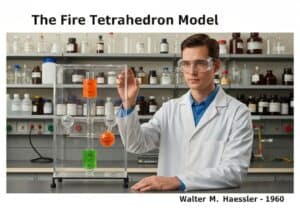Class D fires involve combustible metals, alloys, or metal compounds, such as magnesium, التيتانيوم, sodium, and الليثيوم. These fires are exceptionally hazardous as they burn at extremely high temperatures and can react explosively with common extinguishing agents like water or carbon dioxide. Water, for instance, in some cases, in contrary to popular believes, can dissociate into hydrogen and oxygen, fueling the fire. Specialized dry powder agents are required for extinguishment.
Class D Fires: Combustible Metals
The unique danger of Class D fires stems from the chemical reactivity of the burning metal. Unlike carbon-based fuels, many metals are powerful reducing agents and can strip oxygen from water (H₂O) or carbon dioxide (CO₂). For example, burning magnesium reacts with water in a highly exothermic reaction: [latex]Mg (s) + H_2O (g) \rightarrow MgO (s) + H_2 (g)[/latex]. The hydrogen gas produced is itself extremely flammable, leading to a violent explosion. This makes traditional firefighting methods not only ineffective but dangerously counterproductive.
Extinguishing Class D fires requires agents that will not react with the burning metal. These are typically dry powders, not to be confused with the dry chemical agents used for Class A, B, and C fires. Class D agents work by smothering the fire, forming a crust that excludes oxygen, and by absorbing heat. Common agents include sodium chloride (NaCl) based powders (like Met-L-X), graphite-based powders (G-1), and copper-based powders, with the specific choice depending on the type of metal burning. For instance, copper powder is particularly effective on lithium fires.
The rise of التقنيات like lithium-ion batteries has brought Class D fire safety into sharper focus. While a battery fire is complex, it often involves the combustion of lithium, requiring Class D-rated extinguishing agents and strategies.
النوع
الاضطراب
الاستخدام
السلائف
- the discovery and isolation of reactive alkali and alkaline earth metals
- the development of industrial processes using powdered or molten metals (e.g., in aviation and munitions)
- a scientific understanding of exothermic oxidation-reduction reactions
- analysis of industrial accidents involving catastrophic metal fires
التطبيقات
- fire safety protocols in aerospace and automotive industries using lightweight metals
- handling procedures for alkali metals in chemical research and تصنيع
- specialized fire suppression systems in metal foundries and 3d printing facilities using metal powders
- safety design for large-scale battery energy storage systems (e.g., lithium-ion)
- pyrotechnics manufacturing and storage safety
براءات الاختراع:
أفكار ابتكارات محتملة
!!مستويات !!! العضوية مطلوبة
يجب أن تكون عضوًا !!! مستويات!!! للوصول إلى هذا المحتوى.
متاح للتحديات الجديدة
مهندس ميكانيكي، مشروع، هندسة العمليات أو مدير البحث والتطوير
متاح لتحدي جديد في غضون مهلة قصيرة.
تواصل معي على LinkedIn
تكامل الإلكترونيات المعدنية والبلاستيكية، التصميم مقابل التكلفة، ممارسات التصنيع الجيدة (GMP)، بيئة العمل، الأجهزة والمواد الاستهلاكية متوسطة إلى عالية الحجم، التصنيع المرن، الصناعات الخاضعة للتنظيم، شهادات CE وFDA، التصميم بمساعدة الحاسوب (CAD)، Solidworks، الحزام الأسود من Lean Sigma، شهادة ISO 13485 الطبية
احصل على جميع المقالات الجديدة
مجاني، لا يوجد بريد عشوائي، ولا يتم توزيع البريد الإلكتروني ولا إعادة بيعه
أو يمكنك الحصول على عضويتك الكاملة -مجانًا- للوصول إلى جميع المحتويات المحظورة >هنا<
الاختراع والابتكار والمبادئ التقنية ذات الصلة












